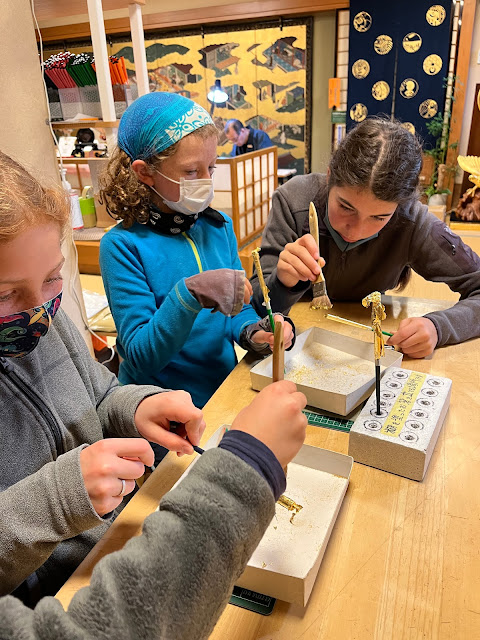I am always trying to make the children's learning appropriate to our location while still making sure they keep up with the rest of the learning we want them to have. Sometimes this involves making their work centered around excursions we are going to have. Or sometimes it is just the excursions themselves. They do learn a lot from just being in a different place and learning about different ways of life. I give them research and work to do to try to ensure they know a little about the place and culture they are in. I try to gauge what interests them about each place and go from there. For example, before coming to Japan Tova said she really wanted to focus on art in Japan. I created a one hour introduction course on Japanese art forms, we went to art museums, the kids had to learn about two artists and try drawing in that style, the kids got to practice Shodo (Japanese calligraphy), we stopped at the dollar store and bought supplies to try our hands at paper cutting...The kids have enjoyed it and learned a lot. Another topic I chose to focus on for our time in Japan is origami.
The kids already enjoyed origami so I thought what better topic to delve into deeper while in its country of origin.
Origami is said to be as old as paper itself. It comes from the words oru (to fold) and Kami (paper). In its early years origami was practiced by monks for religious purposes. It has long been used as an educational tool as it incorporates many mathematical concepts. Akira Yoshizawa, the father of origami who dedicated his life to bringing origami to the rest of the world, initially used it to train factory employees in geometric concepts. While it has evolved from its religious origins, I really like the slightly meditative process of the craft. I think the act of folding paper, in addition to being educational, can be calming and teaches good lessons about patience and perseverance. It is also the sort of thing that the more you do the better you get at it and can be tailored to many different ages. So, I decided that as part of their education the children would be required to do 20 minutes of origami a day for the duration of their stay in Japan. I sort of envisioned kids waking up and starting their day with origami but as it turns out they seem to choose to sit and do origami before bed. I figured they would be doing different projects but they choose to all sit together and do the same origami which works out well for the smaller kids who need more help. And after three weeks I can say they have all definitely improved. Origami time is a peaceful time in our house and a time when the kids seem focused and collaborative. I think Akira Yoshizawa would agree with me when I say that origami could be a great practice to incorporate into non-Japanese school systems.
 |
| Cranes |
 |
| Hokusai reproductions |
 |
| More origami creations |
 |
| A French artist - Yves Klein who was influenced greatly by Japan |
 |
| Made out of cardboard! |
 |
| Trying our hand at gold leaf application |
 |
| These puppies are the cutest! |
 |
| Hokusai style vs. Yayoi Kusama style (by Aurora) |








No comments:
Post a Comment